Physical Address
304 North Cardinal St.
Dorchester Center, MA 02124
The realization that local excision may result in equivalent oncologic outcomes for histologically favorable rectal cancer is not a recent development. Conventional transanal excision (TAE) using traditional anorectal retractors has been associated with substantial margin positivity and tumor fragmentation. This has resulted in significantly higher local recurrence rates and worse long-term survival as compared with transabdominal resection for these lesions.
The development of advanced endoscopic platforms has significantly improved the resection quality for local excision. These platforms allow access to lesions located in the upper two-thirds of the rectum. Better visibility and improved operating ergonomics yields higher quality local excision compared with traditional TAE. In 1984, Dr. Gerhard Buess introduced transanal endoscopic microsurgery (TEM) local excision, which resulted in significantly higher rates of R0 and en bloc resections compared with traditional TAE. A single randomized trial comparing TEM with radical resection for early rectal cancer demonstrated no difference in oncologic outcomes.
Transanal minimally invasive surgery (TAMIS) was first reported in 2010 by Atallah et al. using standard skills and equipment already available to laparoscopic surgeons through a flexible transanal port. TAMIS has a shorter learning curve, greater luminal access, and visibility of lesions, and patients can be placed in the dorsal lithotomy position regardless of lesion location.
Cure rates for early rectal cancer, defined as histologically favorable (i.e., well-differentiated, absence of lymphovascular, or perineural invasion), with invasion into the superficial submucosa (sm1) only (T1N0M0) are high after treatment with radical surgery. Local excision of early rectal cancer should offer cure rates comparable to radical surgery with a goal of improved functional outcomes and reduced morbidity. Appropriate patient selection is critical, and every effort must be made to select patients with minimal risk of lymph node involvement for curative local excision. The National Comprehensive Cancer Network (NCCN) rectal cancer guidelines state that patients with mobile cT1N0 well to moderately differentiated lesions that are less than 3 cm in diameter with no lymphovascular or perineal invasion are appropriate candidates for local excision. Lesions larger than 3 cm may also be eligible for local excision but have poorer outcomes. Complete pathologic evaluation with substaging of T1 lesions using the Kikuchi classification is critical for accurate risk stratification. Lesions that demonstrate invasion deeper than the first third of the submucosa (i.e., sm2/3) are also at higher risk of lymph node metastases and should be strongly considered for transabdominal resection. Strict adherence to these criteria should result in equivalent oncologic outcomes for local excision compared with radical surgery. An analysis of the Surveillance, Epidemiology, and End Results database reported comparable cancer-specific survival between local excision and transabdominal resection, and a meta-analysis comparing TEM local excision and radical surgery for T1 rectal cancer also demonstrated equivalent 5-year overall survival.
Patients should be counseled that final pathologic analysis may unexpectedly demonstrate high-risk features, which requires a radical surgery for cure. An individualized discussion should be performed considering the patient's desires and risk tolerance. Comorbidities, ability to tolerate surgery, and reliability to undergo intensive surveillance should be considered. Similarly, lesions with diagnostic uncertainty (i.e., T1 vs. T2) on preoperative evaluation can be offered TAMIS local excision as an “excisional biopsy,” with further management dictated by the final pathology of the lesion. Lesions that invade the muscularis propria (i.e., pT2) should be offered radical surgery due to the high risk of lymph node metastases.
There are emerging indications for TAMIS local excision for more advanced lesions for patients who are unwilling or unable to tolerate radical surgery. These patients must be presented at a multidisciplinary tumor board for consideration of chemotherapy and/or radiation in addition to TAMIS local excision. Patients who are medically able to tolerate surgery but are unwilling to accept the functional impairments or risk of permanent ostomy from radical surgery must be advised that local excision in these cases results in oncologically inferior outcomes, and every effort must be made to offer the patient curative radical surgery. Rarely, TAMIS local excision can be performed for palliation of symptoms in patients with extreme comorbidities or in the setting of metastatic diseases. TAMIS can also be performed following definitive neoadjuvant chemoradiotherapy. Wound dehiscence is common in this setting and is associated with significant pain, hospital readmission, and need for fecal diversion.
Lesions that are located within 3 cm of the anal verge may be hidden from access by TAMIS due to the length of operating port (37 to 44 mm in length). The TEM rectoscope also presents difficulties in obtaining a proper seal for very distal lesions. A hybrid approach is possible using Parks retractors to dissect the distal lesion and then introducing the TAMIS port to finish the proximal dissection. This approach allows for the advantages of the advanced endoscopic platforms to be applied for lesions that would otherwise be at high risk of R1 resection and fragmentation by traditional TAE.
Preoperative evaluation begins with a detailed history, including disease-specific and associated symptoms, family history, performance status, functional capacity, fecal continence, and physical examination with particular attention paid to digital rectal examination. Lesions that can be palpated by digital rectal exam should be assessed as to whether they are firm, mobile, or fixed. Full endoscopic evaluation of the colon must be performed to rule out synchronous lesions that may change the management strategy. Rigid proctosigmoidoscopy by the operating surgeon clarifies tumor size, location within the lumen, distance of the lower and upper extent of the tumor from the anal verge, and circumferential extent.
Transrectal ultrasound and pelvic magnetic resonance imaging (MRI) with rectal cancer protocol may be used individually or in combination to stage the tumor locally. Computed tomography of the chest, abdomen, and pelvis and carcinoembryonic antigen level completes the staging evaluation. Routine laboratory investigations and positron emission tomography scans are not necessary. Once the preoperative evaluation is complete, patients should be presented at a multidisciplinary tumor board to arrive at a consensus management plan.
A full mechanical bowel preparation, or more commonly a limited left-sided bowel preparation with the use of enemas, ensures a clear operative field and limits contamination in case of rectal perforation. Antibiotic and venous thromboembolism (VTE) prophylaxis are given in accordance with guidelines for colonic surgery. Foley catheterization may be of benefit in males due to the high incidence of urinary retention.
The patients can be placed in lithotomy position regardless of lesion position within the rectal lumen. The main operative monitor is placed at the head of the bed, and both surgeon and assistant (camera holder) are seated between the legs of the patient. Basic laparoscopic instruments (including graspers, monopolar cautery, and needle drivers) can be used. A 5-mm angled (30- to 45-degree) scope is preferable, as it offsets the operating surgeon's hands to minimize instrument collision, facilitates assessment of the lateral and proximal margins, and can improve visualization around the rectal valves. Simple monopolar cautery, combined suction-cautery instruments, as well as energy devices can all be used for dissection and hemostasis.
TAMIS is performed using the SILS Port (Medtronic, Minneapolis, Minnesota), the GelPOINT Path (Applied Medical, Rancho Santa Margarita, California), Triport (Olympus), and SSL (Ethicon, Somerville, New Jersey). Exposure of the anal canal can be improved with the Lone Star retractor system (CooperSurgical, Trumbull, Connecticut) as required ( Fig. 167A.1 ). The 5-mm camera, hook eletrocautery, suction irrigator, and grasper are introduced through the Gel cap and the operation commenced. Setup time averaged 1.9 minutes in the initial publications of the TAMIS procedure. Pneumorectum is created with carbon dioxide insufflation kept at 15 to 18 mm Hg and can be increased up to 20 mm Hg if required in patients with morbid obesity. A suction device is important to facilitate smoke evacuation. Recently, new insufflators have been developed (AirSeal Insufflation System; ConMed, Inc. Utica, New York), providing improved stability of pneumorectum at lower pressures and dramatically reduce intraluminal smoke, the two most vexing problems found by early TAMIS users.
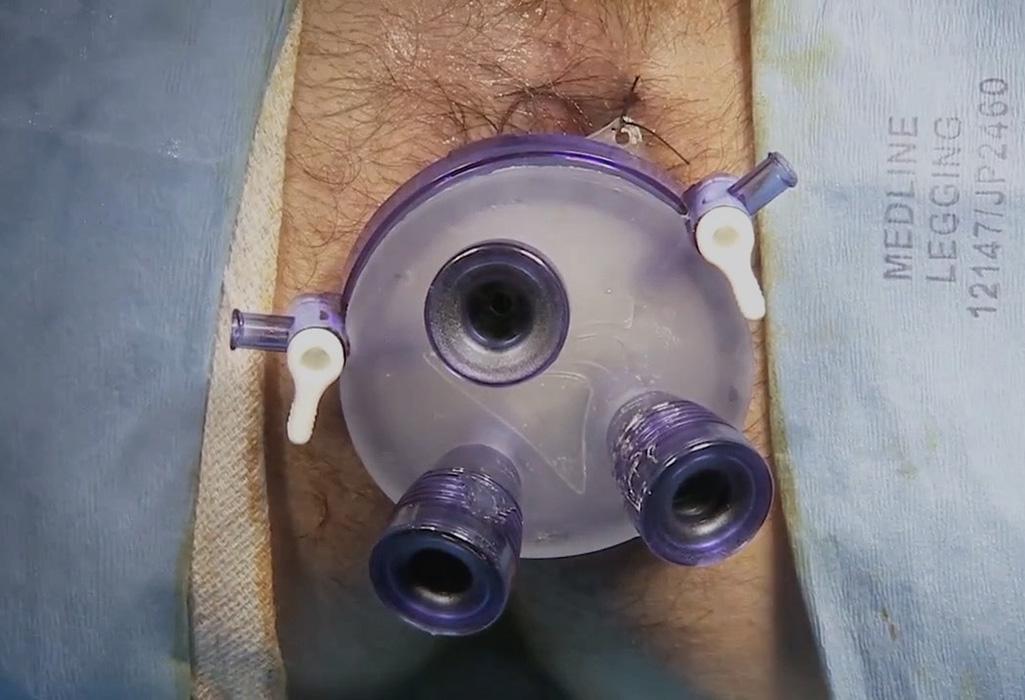
A nonfragmented, full-thickness, margin-negative tumor resection is mandatory. Submucosal dissection, which may be used for benign polyps to minimize risk of wound complications, has no role in early rectal cancer. The procedure begins by marking out a 1-cm circumferential margin using electrocautery ( Fig. 167A.2 ). Full-thickness perpendicular incision of the rectal wall, distal to the lesion, allows manipulation of the specimen without direct contact of the tumor. Mesorectal fat serves as the deep margin ( Fig. 167A.3 ). The specimen should be grasped on the edge of normal mucosa or underneath the lesion on the mesorectal fat to minimize fragmentation of the tissue and tumor. Some surgeons advocate en bloc removal of mesorectal fat beneath a posteriorly placed lesion in an attempt to retrieve lymph nodes. The sampling of involved lymph nodes may alter treatment recommendations. Care must be taken to avoid breaching the mesorectal fascial envelope to minimize disruption of the anatomic planes should proctectomy become necessary.
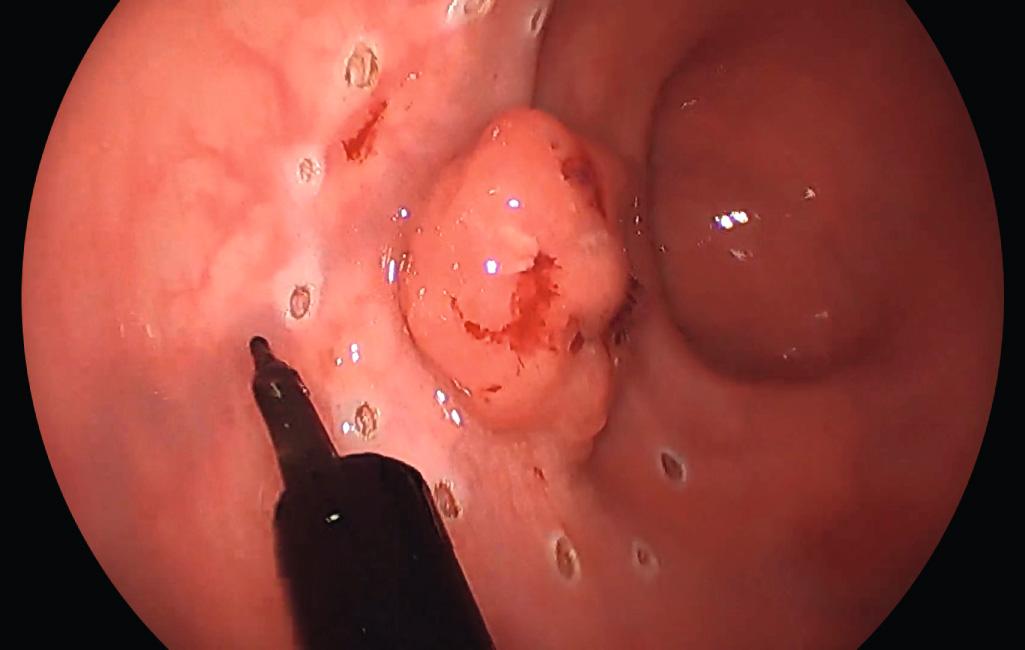
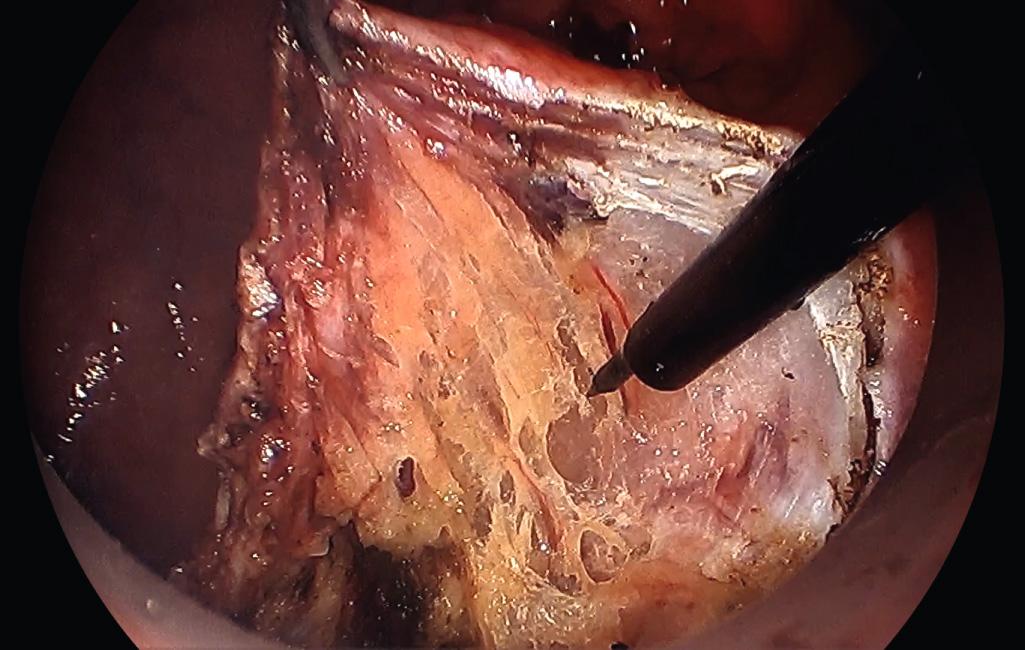
Anterior lesions are still best accessed in the lithotomy position, in contrast to conventional TAE or TEM where the prone jackknife position is necessary. Injury to the prostate or vagina is possible anteriorly where the mesorectum is much thinner, but this has not been reported in any series of TAMIS. Familiarity with the anatomic planes and surrounding critical structures is important. Peritoneal entry is a known risk (4%) in patients with anterior tumors located in the mid and upper rectum. Closure of the rectal wall must be performed by first closing the peritoneum and then the rectal wall. However, transient loss of pneumorectum may occur. Rarely, laparoscopic access is required to cleanse the pelvis, facilitate wall closure, or perform a leak test. In our experience of more than 250 TAMIS procedures, conversion to transabdominal laparoscopic closure occurred more frequently within our first 100 procedures and may have been associated with failure to maintain stable pneumorectum to permit safe endoluminal closure. Peritoneal entry has not been associated with increased pelvic infection or worse oncologic outcomes. Informed consent in patients at risk of peritoneal entry should be strongly considered.
The specimen should be oriented ( Fig. 167A.4 ), pinned out and sent to the pathologist as a fresh, nonpreserved specimen to facilitate margin evaluation. Strong consideration should be given to reexcision of a positive margin or formal radical oncologic surgery.
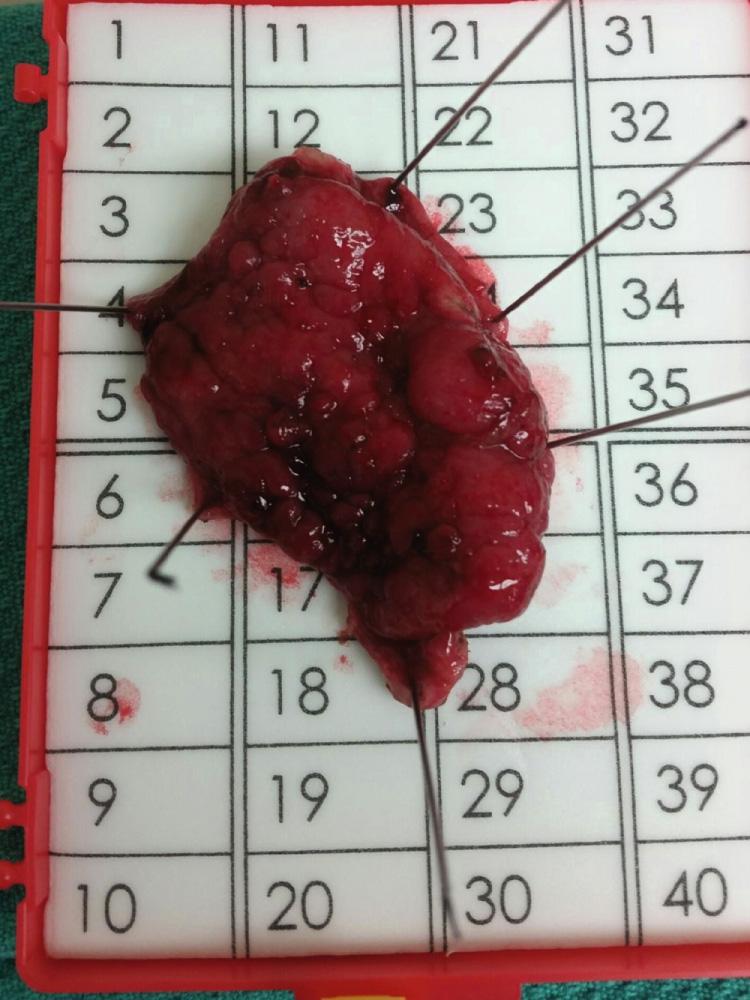
It is easy to irrigate the rectum with povidone-iodine (Betadine) and can potentially minimize bacteria and tumor contamination. The best method of handling the defect in the rectal wall is debatable ( Fig. 167A.5 ). All full-thickness defects are closed with interrupted or continuous suturing. Hahnloser et al. reported outcomes from 75 TAMIS excisions performed at three centers and found no difference in complications between defects that were closed and those that were left open. The rectal defect is closed transversely so as not to narrow the lumen. During the suturing process, it is best to reduce the intraluminal pressure to 8 to 10 mm Hg to reduce tension on the suture lines. A running closure beginning in the lateral portion of the incision can be achieved but is technically more challenging. The use of a V-Loc suture (Covidien, Mansfield, Massachusetts) can expedite continuous closure by maintaining tension and negating the need for knot tying ( Fig. 167A.6 ). Conversely, closure can be performed in an interrupted fashion with knot tying facilitated by laparoscopic knot pushers. The use of modern suturing devices can significantly shorten the learning curve at the expense of increased procedural costs. Laparoscopic knot tying devices and methods are available ( Fig. 167A.7 ). A rigid or flexible sigmoidoscopy can also be performed at the end of the procedure to access the luminal diameter.
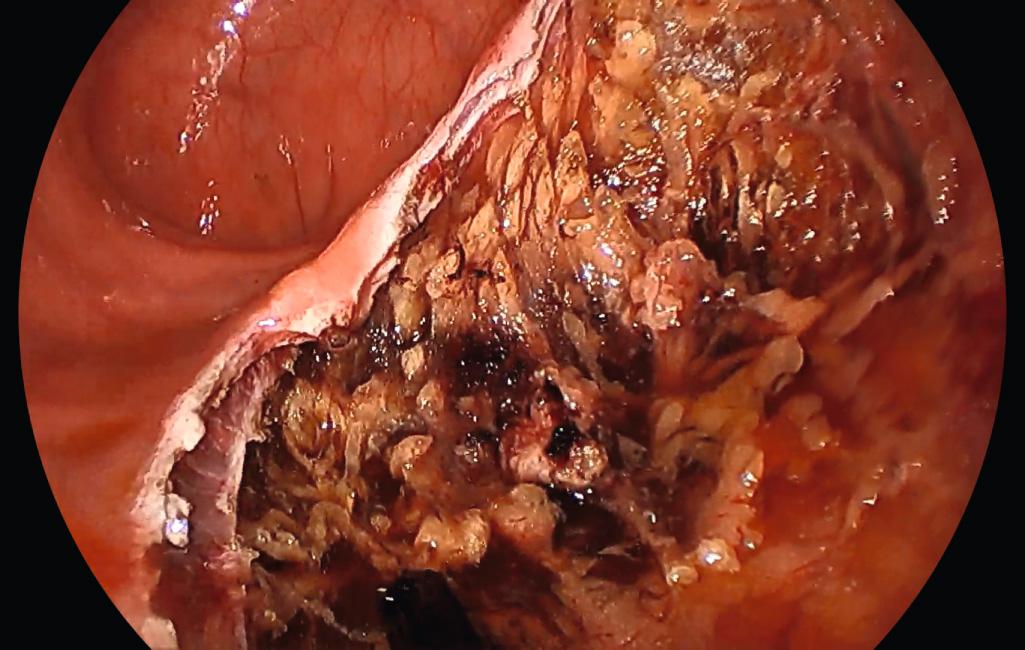
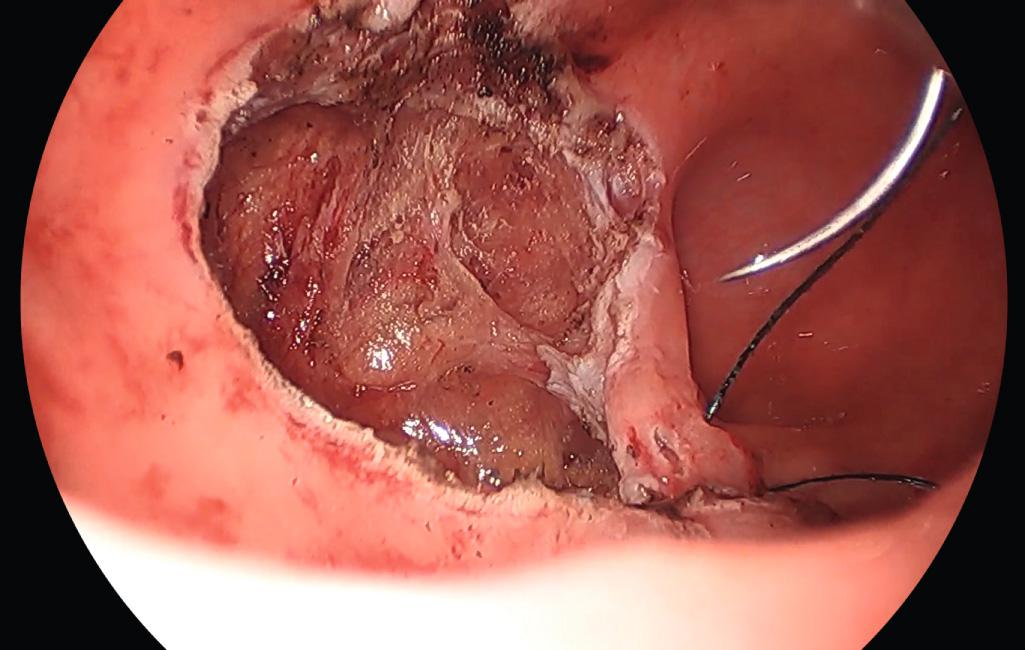
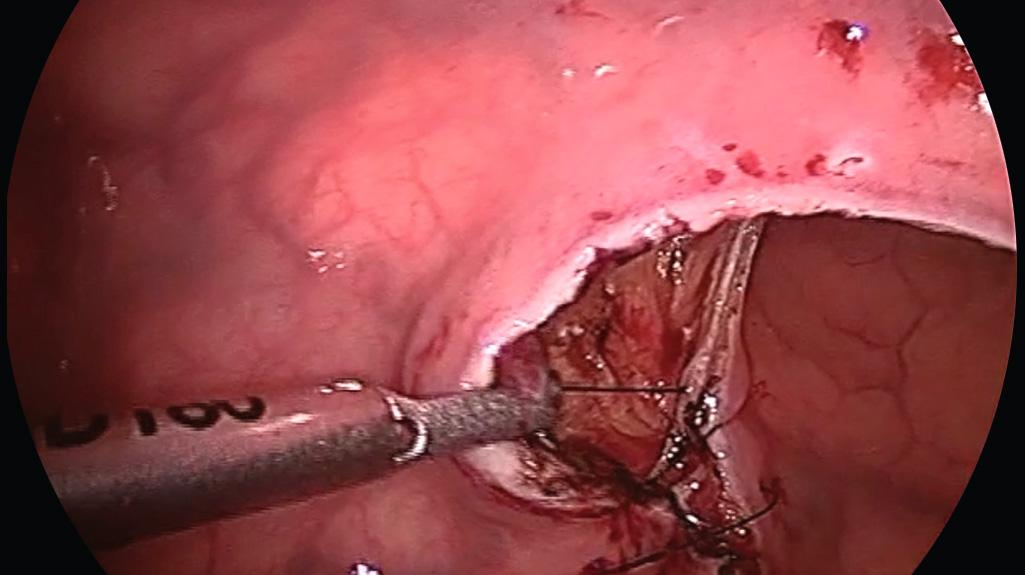
TAMIS has been performed robotically with good success. However, robot docking time, which can be up to 36 minutes, and the additional costs incurred by the use of the robot equipment (up to 1000 Euro per patient, excluding capital expenditure on the robot system and its maintenance), limit the applicability of robotic TAMIS.
Become a Clinical Tree membership for Full access and enjoy Unlimited articles
If you are a member. Log in here